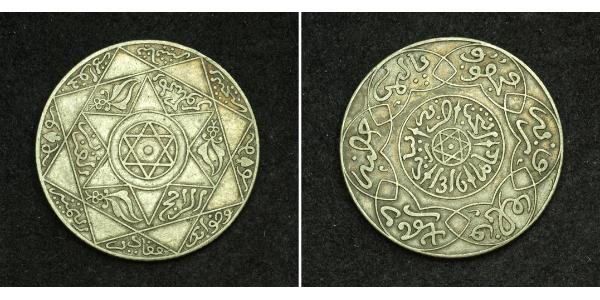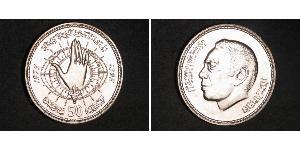5 Dirham (Vendida por $23.0)
1899, Morocco, Mulai Abd al-Aziz IV. Scarce Silver 2½ Dirhams (1/4 Rial) Coin. aXF! Mint Place: Paris Condition: About XF! Reference: KM-Y#11.2. Mint Date: 1898 (AH1315) Denomination: Quarter Rial (2½ Dirhams) Material: Silver (.835) Diameter: 26mm Weight: 7.14gm Morocco has a very important strategic location, as a gateway to western Europe. This has resulted in the nation being attacked and subjugated by many invaders from the Phoenicians and Romans to the more modern French and Spanish. At the time of the mintage of this coin, Morocco was under French control. Of interest, is the fact that Morocco was the first nation to recognize the sovereignity of the United States in 1777. em>. Abdelaziz of Morocco (1878 - 1943), also known as Mulai Abd al-Aziz IV, served as the Sultan of Morocco from 1894 at the age of sixteen until he was deposed in 1908. He succeeded his father Hassan I of Morocco. He was a member of the Alaouite dynasty. By the action of Si Ahmad bin Musa, the Chamberlain of El Hasan, Abd el-Aziz's accession to the sultanate was ensured with little fighting. Si Ahmad became regent and for six years showed himself a capable ruler. On his death in 1900 the regency ended, and Abd al-Aziz took the reins of government into his own hands and chose an Arab from the south, El Menebhi as his chief adviser. Urged by his Circassian mother, the sultan sought advice and counsel from Europe and endeavored to act on it, but advice not motivated by a conflict of interest was difficult to obtain, and in spite of the unquestionable desire of the young ruler to do the best for the country, wild extravagance both in action and expenditure resulted, leaving the sultan with depleted exchequer and the confidence of his people impaired. His intimacy with foreigners and his imitation of their ways were sufficient to rouse fanaticism and create dissatisfaction. His attempt to reorganize the finances by the systematic levy of taxes was hailed with delight, but the government was not strong enough to carry the measures through, and the money which should have been used to pay the taxes was employed to purchase firearms instead. And so the benign intentions of Mulai Abd el-Aziz were interpreted as weakness, and Europeans were accused of having spoiled the sultan and of being desirous of spoiling the country. When British engineers were employed to survey the route for a railway between Mequinez and Fez, this was reported as indicating an absolute sale of the country. The fanaticism of the people was aroused, and a revolt broke out near the Algerian frontier. Such was the condition of things when the news of the Anglo-French Agreement of 1904 came as a blow to Abd-el-Aziz, who had relied on England for support and protection against the inroads of France. On the advice of Germany he proposed the assembly of an international conference at Algeciras in 1906 to consult upon methods of reform, the sultan's desire being to ensure a condition of affairs which would leave foreigners with no excuse for interference in the control of the country, and would promote its welfare, which Abd-el-Aziz had earnestly desired from his accession to power. The sultan gave his adherence to the Act of the Algeciras Conference, but the state of anarchy into which Morocco fell during the latter half of 1906 and the beginning of 1907 showed that the young ruler lacked strength sufficient to make his will respected by his turbulent subjects. In May 1907 the southern aristocrats, led by the head of the Glaoua tribe Si Elmadani El Glaoui, invited Abdelhafid, an elder brother of Abd el-Aziz, and viceroy at Marrakech, to become sultan, and in the following August Abdelhafid was proclaimed sovereign there with all the usual formalities. In the meantime the murder of Europeans at Casablanca had led to the occupation of that port by France. In September Abd-el-Aziz arrived at Rabat from Fez and endeavored to secure the support of the European powers against his brother. From France he accepted the grand cordon of the Legion of Honour, and was later enabled to negotiate a loan. This was seen as leaning to Christianity and aroused further opposition to his rule, and in January 1908 he was declared deposed by the ulema of Fez, who offered the throne to Hafid. After months of inactivity Abd-el-Aziz made an effort to restore his authority, and quitting Rabat in July he marched on Marrakech. His force, largely owing to treachery, was completely overthrown on August 19 when near that city, and Abd-el-Aziz fled to Settat within the French lines around Casablanca. In November he came to terms with his brother, and thereafter took up his residence in Tangier as a pensioner of the new sultan. However the exercise of Moroccan law and order continued to deteriorate under Abdelhafid, leading to the humiliating Treaty of Fez in 1912, in which European nations assumed many responsibilities for the sultanate, which was divided in three zones of influence. King Abdulaziz led a very active social, but semi-political life in his exile. During the Spanish annexation of Tangier in 1940, he acquieced insofar as the Moroccan palace authorities called the "makhzen" played a significant role therein. Ahmed Belbachir Haskouri, then, Secetary General of the "Makhzen" in Spanish Morocco, spearheaded the "makhzen" march into Tangier.[1] Belbachir eventually became the ex-sultan's "interlocuteur" (political broker) with the Moroccan nationalist exiles in Tangier at the time. Belbachir was continuously making arrangements and setting the parameters for such secret meetings. As a consequence, the nationalists were led in disguise to the ex-sultan's palace to discuss the progress of the nationalistic movement within the framework of a future emergent and independent Morocco. After the ex-sultan's sudden death in 1943, Belbachir parleyed with the Spanish authorities for the transfer of his body to French Morocco as desired by the Sultan Mohammed V of French Morocco. Due to questions of territorial integrity, the Spaniards were initially unwilling to comply accordingly, but gave in as Belbachir continued to impose himself. In the final analysis, Belbachir accompanied the body to Fez where the ex-sultan was buried with the full rights of a head of state. He was portrayed by Marc Zuber in the film The Wind and the Lion (1975). Only 1$ shipping for each additional item purchased!
más ...
Precio
Usted podría estar interesado en las siguientes monedas
2024-04-17
- New coin is added to 8 Maravedi Kingdom of Spain (1814 - 1873) Cobre Isabella II ...
8 Maravedi Kingdom of Spain (1814 - 1873) Cobre Isabella II ...
grupo tiene 4 monedas / 2 precios
⇑
1847, Spain, Queen Isabella II. Nice Copper 8 Maravedis Coin. (XF-) Jubia mint!
Mint Year: 1847
Mint Place: Jubia (Ja)
Denomination: 8 Maravedis
Reference: Cal 484, KM-531.2.
...
2024-04-18
- New coin is added to 20 Kreuzer Imperio austríaco (1804-1867) Plata
20 Kreuzer Imperio austríaco (1804-1867) Plata
grupo tiene 7 monedas / 6 precios
⇑
1856, Austria, Francis Joseph I. Gilt Silver 20 Kreuzer Coin. (XF-AU) Kremnitz!
Mint Year: 1856
Reference: KM-2211.
Mint Place: Kremnitz (B)
Denomination: 20 Kreuzer
Condition: Gol ...
Usted podría estar interesado en …





 English
English





-300-150-3EmsHgTyjVUAAAGOWPsHkTUG.jpg)

-300-150-zHCsHgTydS0AAAGNd3rZkR_B.jpg)






